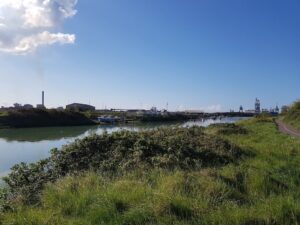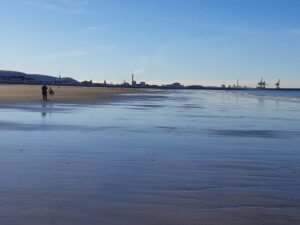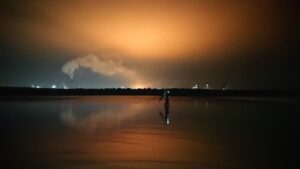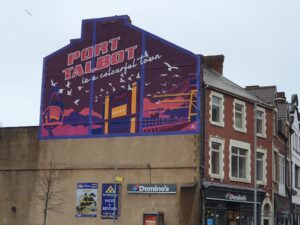Having lived all his life in its shadow — and with big change looming — Simon Smith considers the history, physicality and cultural significance of Port Talbot Steelworks.

For several hours already, you’ve been striking west. The motorway’s tarmac has tracked by, mile-by-mile, like tickertape beneath the tyres, and still your destination is no more than an unseen point somewhere in the far distance beyond the sunset that burns like a fiery backcloth behind Swansea.
You’re tired now.
The last traces of caffeine from that Styrofoam cup of coffee an hour ago and, perhaps, the best efforts of some guitar band, twanging like tinnitus through the car’s speakers, are all that keep you alert. Weston Super-Mare is already a distant memory, Cardiff passed in a blink and now you’re simply counting off the exits as they slip by in a fatigued blur: Bridgend, Porthcawl…Suddenly, just as the tiredness threatens to overtake you fully, you snap to full consciousness as you’re zapped from the journey’s ongoing forgotten-by-rote past tense, and propelled into some weird and breathtaking melding of present and future.
Out of the looming darkness to your left-hand side, a light builds quickly, an indistinct shine that rapidly grows and takes definition until what seems a huge mothership, with its massive banks of light, blazes through the gloaming. These, though, are not the dead lights of some cold, distant star fallen to Earth. Rather, it feels as though some vast tubular city rises from its own foundations even as you watch on, an idea rendered at least partly true due to the fact that this exact vista, on this very stretch of motorway, is reputed to have inspired Ridley Scott’s visualisation of the cityscapes for his cult film, Bladerunner. If you have ever watched that iconic opening scene with its cyberpunk bird’s-eye panoramas and flaming towers, then you have seen this: Port Talbot Steelworks.
Wedged between the hills to its rear and the sea at its front, and with the green cape of Margam Park and Kenfig Nature Reserve nestled around its shoulders, the steelworks occupies an area of land around six square miles in size, a small town nestled within a town in an area that, at one time, may have almost rivalled the fabled Gower peninsula with its natural beauty. However, this was never to be the path for Port Talbot.
From as early as the thirteenth century, the monks of Margam Abbey, the locally-founded sister house to the great Abbey of Clairvaux in France, had realised the industrial potential in the surrounding areas. They began open cast mining near the village of Bryn nestled up in the Afan valley, or Cwm Afan, the Welsh term that gives its name to the nearby village of Cwmafan, and from there a gleaming vein of molten metal runs in a direct line through the town’s history, gathering momentum following the Industrial Revolution, leading to copper working, tin working and, of course, steel working.

When looking back through history, it is often remarkable how fate seems to find its own path, leading events and places in a certain direction, even from afar. Following Pope Clement VII’s refusal to grant Henry VIII an annulment of his marriage to Catherine of Aragon, and the subsequent religious schism torn open in the years that followed, the ensuing dissolution of the monasteries led to Margam falling into the hands of Sir Rice Mansel. Two and a half centuries later, his descendent, the great Victorian industrialist Christopher Rice Mansel-Talbot would build Margam Castle, a little-used residence in the grounds of Margam Park. A tourist attraction these days, it stood as a metaphor of control, of power, of progress and any other force you might care to imagine. Like some local squire, Talbot’s presence became more and more prevalent in the local area, permeating the metal works, the rail links and the docks that sprang up throughout the environs, the moniker bestowed upon the latter eventually fulfilling the legacy as it was adopted for the spreading town, writing Talbot’s name onto the maps for centuries to come. The man became the place, the place became the man — Port Talbot — a mutual relationship bringing financial stability and growth to an area over which the blast furnaces have stood, and for the time being still stand, as monolithic, pipe-worked clefs, which have always seemed to call the tune.
From the hills to the strands, from the parks to the gardens, the steelworks can be seen from anywhere in the town.
But although an imposing physical presence, to anyone who has lived in and around Port Talbot, the steelworks is much more than this, embedded as it is into local lives, settled and part-rusted into the background, its cooling towers and conveyer belts by now a much expected and accepted set of contours in the skyline and its pulsing after-dark glow our aurora industrialis.

To the residents of the town, the steelworks resides beyond the physical, inhabiting lives through the mythical, such as the long-held talk of big cats that stalk the marshlands around the works, but through the literal and emotional memory of the townspeople too.
Scratch the surface and beneath a thin layer of rust, you will soon find a residual sense of rawness over that November day in 2001 when the skies rocked to the hammer blast of an almighty explosion before darkening quickly as they filled with smoke. The airwaves clogged with phone calls, television broadcasts and radio signals as everybody scrambled to make sense of what had happened. Families desperately phoned loved-ones frantically attempting to discover whether they were on shift at the time. I can still remember the relief that flooded over me as my father picked up his phone on the third ring. Everywhere, reporters asked questions, filmed intros and outros at various points around town, radios blared out punctuated updates and TVs bounced images around the country carrying the news that Port Talbot had always feared, and secretly hoped would never come. Three of our own were lost that day, including a close personal friend of mine with whom my wife and I had shared a pint and a few laughs only a handful of nights before.
Years have passed, but the town has never forgotten. It will never be able to forget. The small, daily reminders are always there in the miniscule metallic flakes glittering in the sunshine as they flick and flap along lines of freshly-laundered washing; the older white UPVC window and door frames are still stained as pink as washed-out bloodstains by the iron ore dust borne inland from the docks by the prevailing winds.
It would be too simple, though, to portray the place as some all-devouring Grendel come to prey on our darkest dreams. Where it has been destroyer, it has also played provider, at one time employing twenty thousand people from the local environs, providing such a good living that it became known as ‘Treasure Island’. Again though, just as the physical presence of the place cannot adequately capture its deeper presence here, so the financial benefits do not fully justify the draw of the place.
Even as a child I always felt that the steelworks had a terrible beauty all its own. Maybe beauty is too strong, or too simple, a word, but it definitely held an appeal in that way that an innocuous lightbulb draws moths. Whenever I looked across the river near my home toward the steelworks, I always thought of Dickens’ Hard Times and the way that its ‘fairy palaces burst into illumination before pale morning showed the monstrous serpents of smoke trailing themselves over Coketown.’ Those lights, ever-present, always burned bright, night and day, always pulling, always harbouring fascination.
What added to its attraction was the fact that the edge of the works butted up to Morfa beach, a local beach that still holds two of the UK’s shore-caught fish records (dab and hake). It glittered not only with ore dust but with more of those local myths, carried this time via the stories of monster fishes caught or witnessed by relatives of friends, and tales of ones that got away following gargantuan fights and catastrophic tackle failures in those dusty third and fourth hand tales passed on over shop counters and half-remembered summer gossip. In the Welsh language, the word ‘morfa’ literally means ‘marsh’, and to a bookish young A-Level student who had chosen the academic route rather than follow that well-trodden path to the blast furnaces and rolling mills followed by so many of my peers, and whose head was filled with imagined pictures from Dickens’ Great Expectations to the Dead Marshes in The Lord of the Rings, every single factoid, half-truth and tall tale was grist to the mill of my imagination.
Morfa held that impossible magic for, despite having lived in the local area all my life, and having fished the local beaches throughout those years, Morfa was the only one I had not fished at that point due to its route through the works, a route only used by those who worked there, who were part of its story. Even though I was a local boy, where the steelworks were concerned I was very much an outsider looking in. Together, the beach and the steelworks combined in my mind, hanging there as some kind of great mystic presence, a near entity yet one that might have been as remote as Jupiter for all I could manage. I had to fish it.
The first time I ever did so was at seventeen years old, when a friend of mine passed his driving test. Without the slightest hint of hesitation, we chose the first evening on which we were both free, bundled ourselves, all our fishing tackle and our cold weather gear into his tiny red Ford Fiesta and drove through the gates at the seven o’ clock shift change, losing ourselves amongst the stream of cars in an effort to get to Morfa beach.
Within minutes of entering those gates, we were hopelessly lost, reduced to shambling around in first gear like seedy kerb-crawlers. With each yard we drove trying to find our way to the beach or even, by this point, back out into the real world again, we were pulled deeper inward. Everywhere we looked pools of shadow oozed from cracks in walls, trickling outward to gloomy obscurity amongst the miles of tarnished pipes. Through the steam and shade those metallic coils wound low to the ground, hissing into the cool air as we passed. Turning a corner or reaching the end of a track, the murk would occasionally flare up, punctuated by the sudden neon pinpoints of cigarettes that, for a split-second, illuminated the face of the smoker with each drag and further riveted the darkness around it into place. Fritz Lang or Alfred Hitchcock would have had a field day amongst the noir-ness of it all, though even then it carried a lingering sense of endings, and we could sense it fading even as we watched. A cast of thousands had whittled down, year upon year, to this, a final fraction of those heyday crowds, the last few lonely extras loitering around before the final fade-out of the lights.
The session itself was unremarkable as I remember it. No record-busting fish, no rod-bending stuff of dreams, only a handful of whiting and pouting interspersed the hours until we clambered back up from the beach and wearily trudged back to the car. Over the intervening years, any haunting mysticism surrounding the place has long since been dispersed; numerous fishing sessions since that first have transformed the superstitious curiosity and tidied everything away into the neat physical and contextual corners of psychogeographical interest. Looking back from the surf line, even taking in Sker point to the east and the harbour with its ‘longarm’ of rocks to the western end, this place seems to have lost all impetus. In a crumbling crust of slag, the works butts up to the beach like some terminal moraine or the long-cooled snout of a lava flow. The massive ore ships that fascinated me as a boy, arriving from the far ends of the Earth with their huge cargoes of raw materials and foreign crews, now simply wallow in the harbour as the cranes go through the drudge of unloading them, tied metaphors-in-waiting for some second-rate interpretation of Homeric legend.
Despite numerous name changes and shifts in ownership, the slow and lingering death of steelmaking in Port Talbot goes on. With recent news of the shift toward arc furnace-generated greener steel, the final fade of those lights seems closer than ever. As things stand, those blast furnaces will no longer call any tune and even those ships are soon to be a sight from the past around here. The recently announced shift in focus from traditional steel production to arc furnace-driven steel recycling will see the arrival of iron ore as a thing of the past.
Leaving the boats behind now, drifting along to the other side of the harbour’s breakwaters and trailing with the flow of the river Afan past the grinding lock gates and the rust-spattered hulls of the few remaining fishing boats, there you will see, sticking out from the offal-slick mud banks, the Victorian sewage outflow pipes that sit nosing through the weed, broken netting and sun-bleached plastic, navigation points for the eels and the mullet shoals that swim upstream on the rising tide, gliding over the shining black rocks of slag-glass beneath them, moving silently as the cloud shadows that pass inland, away from Morfa and its cousin Aberavon Beach, over the dark corners of dereliction and decomposition, the rusted and ramshackle, the condemned bridges and beams of the fallen factory roofs that stick into the sky like the ribcages of fallen giants. Decay, dereliction, abandonment – these are nothing new in industry and they are nothing new in industrial towns: everywhere you care to look you will see small signs offering testament to the struggles of what it is to move toward reinvention, to rebirth.

A cultural sentimentality seems to have begun to attach itself to the steelworks now, as it begins to make appearances in artwork ranging from photographs in the local branch of Morrisons, to the graffiti artwork boom ignited in the wake of Banksy’s Season’s Greetings, and even in local art galleries, where the shadowy silhouette of the works tends to appear in front of a dusky backdrop or the bluey-purples of a morning sky. These images all seem to hark back, to look at the steelworks through rose-tinted spectacles. Already, it seems that some people are trying to soften the blow in their own ways, to justify their readiness to move on by using a schmaltzy broad brush upon thought and memory as they usher them into past tense.
Perhaps prompted by this slight shift in mentality, the town has started to regenerate itself. Gentrification has already begun to sweep away chunks of the old and, with the last year’s announcement of Freeport status for the area, the talk around town is of jobs, a topic that has flowed quietly like an aquifer for so many years but now fights its way to the surface in a topical torrent as the metallic ring of the headlines, with their talk of ‘hammer blows’ and ‘death knells’, still hang in the air. However, that transition will not take place yet. There are still persistent whispers of marches and protests; there are also questions of self-sufficiency and national security, just as there are counter arguments of the need for greener steelmaking and its place amongst wider environmental concerns. No doubt, opinions will divide and join, polarise and meld in many ways and forms over the coming weeks and months. Hopefully, from the white heat of argument there may come optimism that a new iteration lies in wait for those harbours and docks, new life waiting to be breathed into the local economy around this little town. Maybe, just maybe, stamped as it is with the name of one of Britain’s greatest industrialists, this town may manage one day to rise from the ore dust and find that it is able, finally, to forge a new identity.

*
Simon Smith is an English teacher, poet, nature writer, angling writer and essayist living in Port Talbot, on the Welsh coast. He has published two books: ‘Running with the Tide’ with The Medlar Press and ‘Waiting for a Hunter’s Moon’ with Cambria Books. He occasionally blogs here.